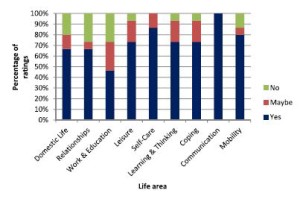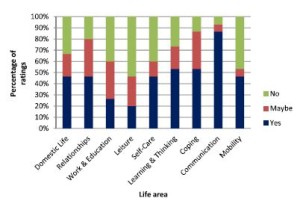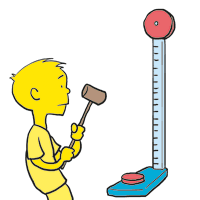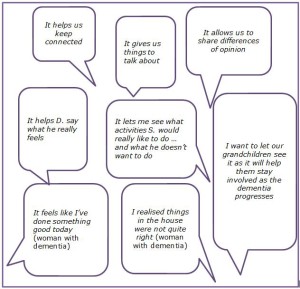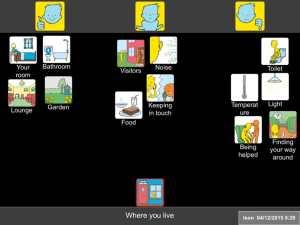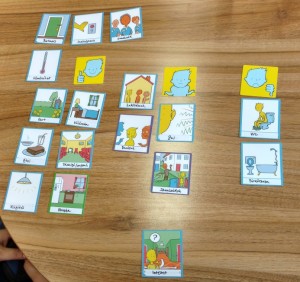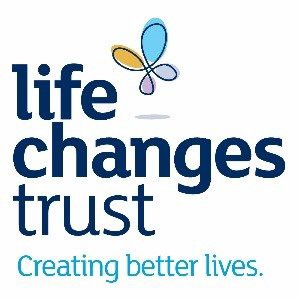We have been exploring how Talking Mats can be used as a tool to support business – both a framework for interviews and appraisals. Because it supports reflection, it is an ideal framework for employers to use with job candidates.
The recruitment process is time consuming for organisations, and any errors at this stage can be costly for teams. When I applied for the post of associate with Talking Mats I wasn’t surprised that the actual interview was engaging and different from any other interview experience.
The first part was for the candidates to teach the interview panel a skill, in 5 minutes. As a speech and language therapist this made a lot of sense to me, as teaching people a skill is more empowering than merely sharing your knowledge.
The second stage of the interview was using a Talking Mat to consider my levels of confidence in relation to aspects of the post.
Having used Talking Mats with children and parents in my clinical work, I wasn’t used to being ‘on the other side of the mat’, and experienced first-hand the positive aspects.
Firstly, it gives the interviewee permission to break eye contact. This immediately takes away the pressure of non-verbal feedback from the panel e.g. if one of the panel is smiling encouragingly, it is tempting to focus on that one person and possibly say too much. The focus being on the cards and the actual mat can reduce anxiety, supporting people to clearly express their views.
Another aspect of Talking Mats is that the person interviewing, hands to the candidate a picture card on one aspect of the topic e.g. knowledge and skills.
The multi sensory aspect i.e. auditory , tactile and visual, supports the candidate to focus on this one concept and share his or her reflection.
The conversation is then built up and captured on an actual mat and the candidate has the opportunity to move the options on the scale as the conversation progresses.
Talking Mats as a communication tool maximises the capacity of individuals to say what matters to them. How many people leave an interview feeling they didn’t say what they wanted to?
P.S. I got the job!
We are very grateful to Lauren Pettit and her colleagues from Pretoria, South Africa for sending us their published paper on a recent research project which used Talking Mats as a research method.
The study’s aim was to describe and compare the views of adults with aphasia, their significant others and their speech and language pathologists regarding the importance of nine life areas for the rehabilitation of adults with aphasia.
They used Talking Mats to support 15 adults with expressive aphasia to rate 9 life areas in terms of importance to them. The 9 life areas they included were Domestic Life, Relationships, Work and Education, Leisure, Self-care, Learning and Thinking, Coping, Communication and Mobility. These are taken from the World Health Organisation International Classification of Functioning Disability and Health (WHO-ICF). The researchers also obtained the ratings of 15 significant others and the 15 speech and language pathologists treating them.
They found that most life areas were rated as important to work on in rehabilitation by most participants. However, there were some discrepancies between the views of the adults with aphasia and the other 2 groups in the study and significant discrepancies were noted for 3 of the 9 life areas.
The graphs below show the comparisons of the 3 groups of participants. Click on graphs to enlarge
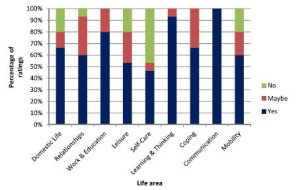
The researchers suggest that ‘These life areas can provide the ‘common language’ for team members to engage in dialogue and identify problem areas related to the daily life functioning of people with expressive aphasia. By simplifying some of the labels of the activities and participation dimensions of the WHO-ICF and pairing these labels with pictures and the interactive Talking Mats interview procedure, adults with expressive aphasia (who often have difficulty participating in the selection of rehabilitation priorities) were able to express their own views. This may be a first step in assisting the adult with aphasia to advocate for themselves and to exercise their right to identify the activities and participation opportunities which they would like to access, and to set rehabilitation priorities based on their choice. While the overlap in priorities among the three groups as found in this study is encouraging, the presence of some significant differences underlines the importance of the voice of adults with aphasia themselves. This ensures truly client-centred rehabilitation that underscores the principles of human rights and a focus on competence rather than deficits’.
To link to the full article: http://dx.doi.org/10.1080/10749357.2016.1207148aphasia
Please contact info@talkingmats if you would like to discuss using Talking Mats in research
Castle Hill High School has seen the benefits of using Talking Mats to let pupils have their say and be involved in planning outcomes. Jenna McCammon, Speech and Language Therapist & Rebecca Highton, Speech and Language Therapy Assistant, Stockport NHS Foundation Trust explain how they are using Talking Mats at Castle Hill High School.
Talking Mats has been beneficial in supporting young people with communication difficulties in school.
A Talking Mats approach has been used to support a pupil who presents with selective mutism. He started refusing to engage in lessons and activities, so school wanted to find out what he enjoys doing and how best to support him. Talking Mats allowed the speech and language therapy team to find out about his likes and dislikes at school, along with the reasons why he was refusing to engage in certain lessons. The sessions allowed the speech and language therapy assistant to build rapport with the pupil through finding out what he enjoys both in and outside of school, and the pupil communicated verbally during one of the sessions for the first time since his change in behaviour. The speech and language therapy assistant took pictures of the finished piece of work and asked permission from the pupil to share this with school staff. The speech and language therapy assistant was able to feed back the outcomes with staff and with other professionals during TAC meetings. Staff and other professionals would then request if the speech and language therapy assistant could obtain more information from the pupil, when needed, using Talking Mats.
Safeguarding – A possible safeguarding issue was suggested by a pupil during a therapy. The pupil has significant communication difficulties and so the information she was able to provide was very limited. The safeguarding officer in school requested if the speech and language therapy team could try to find out more. This was done us using Talking Mats, which allowed the pupil to share more information about the issue which was then shared with the safeguarding officer.
Motivational Interviewing is a tool used by the speech and language therapy team, both when assessing a new referral and when completing a review assessment in order to set new therapy targets. It is an opportunity for the young person to express their opinion, and can also be used to determine how much insight they have regarding their communication abilities. This is usually done verbally using a 10-point scale, however Talking Mats has been used by the speech and language therapist when assessing pupils with limited verbal ability. This allows these pupils to voice their views and have a say in their therapy planning. The findings from the Talking Mats motivational interviews then contribute to writing EHCP Reports for the pupil and are used to inform the decision-making process regarding their therapy goals.
Thanks to Jemma and Rebecca for sending these great examples. Change happens when we give young people a listening space.
This blog summarises a project we have completed providing Talking Mats training for families living with dementia. A key aspect of the work done by Talking Mats is to find ways to improve communication for families living with long term conditions. In particular dementia is a long term condition where deterioration in communication will eventually affect everyone. This makes it increasingly difficult to ensure that the person with dementia continues to be involved in decisions about their life.
We have completed a project funded by Health and Social Care ALLIANCE Scotland. Training in the use of Talking Mats was given to families living with dementia and staff who worked with these families. The Alliance Family Training final report highlights how this training helped people with dementia to communicate their views and be more involved in making decisions about their lives.
Families identified issues relating to self-management that they had not previously been aware of and new insights emerged as the following comments illustrate.(click on box to enlarge)
For some family members an important outcome was that Talking Mats helped them see that their spouse was satisfied with many aspects of his/her life. They found this very reassuring as many assumed that the person with dementia was frustrated and discontented.
The following is an example of how using Talking Mats helped with self-management.
When using Talking Mats on the topic of Where you live, G explained that he found it difficult to find his way to the toilet in the night. As a result his wife bought special senior night lights to help him which solved their problem. As a result, night times improved for both of them.
For further examples and information read the full report here Alliance Family Training final report and for further information about Talking Mats Family training please contact info@talkingmats.com
Thanks to Agnes Turnpenny for her guest blog on her research on views of people moving form institutional care in Hungary.
There are approximately 15 thousand adults and children with learning disabilities living in large institutions in Hungary. The average size of these facilities is over 100 places, and living conditions as well as the quality of care are often very poor. The Hungarian Government adopted a strategy in 2010 to close and replace these institutions with smaller scale housing in the community. Between 2012 and 2016 six institutions closed and more than 600 people moved to new accommodation. The Mental Health Initiative of the Open Society Institute and the Hungarian Civil Liberties Union commissioned a study to analyse the experiences of the deinstitutionalisation process and as part of this research we carried out some interviews to explore the views of people moving out of the institutions.
The participants – five men and four women – came from one institution in the North East of Hungary, they all had mild learning disability and some had additional mental health issues. Originally the study intended to explore the experience of moving out but due to delays in the project this was not possible. Instead, we decided to examine the expectations of moving from an institution to a smaller home that allows more independence and personalised support. Although only one of the participants had communication difficulties – thus conventional interview methods could have been utilised – I decided to use Talking Mats in order to help participants to contrast their current situation with expectations about the future.
I selected the ‘Where you live’ topic from the Social Care package with some additional images from the ‘Leisure and Environment’ and ‘Relationship’ topics. (The English labels were covered over with a Hungarian translation as most of the participants could read). The question I asked was “How do you feel about these aspects in the institution?” and “What do you think they will be like in the new home?”. (I forgot to take a mat with us, therefore we had to lay out cards on the table.)
It emerged – unsurprisingly – from the interviews that most participants anticipated the improvement of their living conditions from the move, especially better facilities (mainly bathroom and kitchen). Some also expected other positive changes, particularly less conflict with other residents, less noise and better safety –commenting on the prevalence of theft in the institution. There were also many uncertainties; people said they were unsure about how they would get on with their new housemates, how the new support arrangements with staff would work, whether the neighbours will be welcoming etc. The photos illustrate some these issues.
Overall, Talking Mats proved to be a very useful tool in interviewing participants, who really engaged with the method. The images and the completed mats encouraged further comments and explanations on issues that participants considered important with minimum prompting. The drawings were easily recognised and appropriate in the Hungarian context without any adaptations other than the labels. Finally, I felt that the use of Talking Mats in this particular situation helped to overcome some of the power imbalance between the researcher and the participants by giving them more control when handing over the images.
We are really grateful to Agnes Turnpenny from The Tizard Centre University of Kent for sharing her experience . We really value our European work and European connections.
Engaging with people who have difficulty communicating can take time and may result in misunderstandings which can cost a lot in terms of time and cost and emotion for all involved. Research and anecdotal evidence have both shown that using Talking Mats is efficient and cost effective in that staff or carers can get better quantity and quality of communication with the people they work in a shorter time with than with usual methods of communication. The average time for someone trained in Talking Mats to have a Talking Mats conversation is 15 minutes, although some people may choose to talk for longer.
In addition, staff often rely on relatives to gather information about a person’s needs and preferences. The process of gathering that information can be protracted owing to availability of family members and, because it is second-hand, is liable to misinterpretations. This in turn can lead to frustrations which can damage relationships, result in poor care and cost time.
At a practical level, the feedback from staff has been that the wipe clean, ready-made Talking Mats symbol sets give immediate access to a practical communication tool. Staff compared this favourably with the time taken to source images on-line, print them out, cut them up and develop them to a standard that is infection control compliant.
The Talking Mats team have invested their time and skills over several years to develop topics which are based on sound research. For example the Health and Well-being Resources is based on the World Health Organisation ICF, the Children and People’s Resource is based both on WHO-ICFCY and GIRFEC. The Eating and Drinking Resource has been co-produced with people with eating and drinking difficulties and a range of different professionals. The Talking Mats symbols have been carefully designed to represent both concrete and abstract topics
In addition sending staff on a Talking Mats training course results in a work force which is effectively trained in communicating with a wide range of people as well as having a bespoke communication tool. Using Talking Mats is efficient for organisations both in terms of time and costs.
The Scottish Government has granted further funding for the Keeping Safe Talking Mats training and resources.
This extension coincides with the launch of the Keeping Safe report 2013-2016 at a seminar on Thursday 19th May at the Raploch Community Centre Stirling. It’s great to hold our event during Learning Disability week where the theme is Celebrating Success. This project has undoubtedly been a success. 234 Keeping Safe communication resources are in use across Scotland. Staff who have used the Keeping Safe resource report that it supports Safeguarding and helps people think how their life is going, enabling them to express concerns they might have, either big or small. The impact that the resource has on the lives of people with learning disability is powerful. You can read more about this in our previous blog or in the Keeping Safe report 2013-2016
The seminar on the 19th of May is an opportunity to share experiences and explore further some of the issues that exist for people with learning disabilities.
The next tranche of funding provides more training courses for:
- People who work with adults with learning disabilities in Scotland to learn the skills and use the resource to support listening to their service users and
- The staff who use the resource regularly to become Keeping Safe trainers and support the aim of ensuring adults with a learning disability in Scotland have access to this communication tool. We particularly want to target geographical areas that do not yet have Keeping Safe trainers, e.g. Dumfries and Galloway and Aberdeenshire.
If you work with adults with learning disabilities in Scotland and would like to apply for Keeping Safe training please contact the office info@talkingmats.com Application for
Striling course 19th August and 16th September is here; 20160610 training flier
Aberdeen Course 9th September and 7th of October is here 20160909 Aberdeen flier
Dumfries and Galloway course 20th October and 25th November is here 20161027 training flier
Further courses are being planned in the Autumn in Dumfries and Central Belt .Please contact Info@talkingmats.com if you wish to be sent the relevant flyer
We are delighted to have received funding from Life Changes Trust to work with Patient Opinion to help improve the access to their website by developing a Talking Mats to enable people to tell their stories.
Like Talking Mats, Patient Opinion is a Social Enterprise and has an excellent independent website https://www.patientopinion.org.uk/ that enables people to share their experiences of UK health services, good or bad. They then pass the stories to the right people so that they can learn from them.
The project we are working on is focusing on people with dementia but in the long run we hope that lots of people will benefit. It will bring our two innovative technologies together marrying the expertise of the Patient Opinion website with that of the Digital Talking Mats.
Our aim is that people affected by dementia can use their own voice to share their experiences and make real differences to relationships, services and culture, just as many others are already doing across health and care. We also hope that this work will empower others with communication or cognitive difficulties to share their experiences and be heard in an open and transparent way.
This ground breaking work is being funded and supported by Life Changes Trust, People Affected by Dementia programme. The Big Lottery funded programme is committed to working with people living with dementia and those who care for them, investing resources so that individuals are more able to face the challenges before them, and can exercise more choice and control in their own lives.
We expect the project to take 18 months to complete and have already run focus groups with people with dementia, family members and expert practitioners to plan the new symbols. We are now working with the technical experts to create the website interface which we will then pilot with people with dementia.
Watch this space for more updates…..
Thanks to Alison Matthews for a great guest blog on Talking Mats supporting people with learning disability to have a political voice In the photo from left to right Alison Matthews, John Hendrickson ( chair of NW LDA) , Shahnaz Ashraf, Rosemary Trustam, Darren Heywood (vice chair)
The North West Learning Disability Alliance (LDA) is a campaign group focussing on the rights of people with learning disabilities. The NW regional self -advocates forum met twice to identify their priority concerns which were due to be discussed at the regional conference in Blackpool. Members of the NW LDA attended a conference planning event and we discussed ways in which people could be supported to voice their views on services. It was agreed that given the need for local and national politicians representing their citizens to hear the views of people with learning disabilities, the conference would be a way to develop this with the help of social media. The NW LDA was then invited to have a stand at the conference in Blackpool.
Talking Mats seemed the obvious approach to support discussions around the concerns as it provided a structured means of people expressing their views and provided potential objectivity in that people could also praise services, as well as voice concerns, which in fact some did! We wanted to take photographs of people with their mats as we felt it would bring the concerns or issues to life, it certainly seemed a more powerful way of enabling people to speak out. Our idea then was to e mail relevant local councillor or MP and to support people to get their voices heard wherever possible.
Some of the challenge was in planning the vocabulary needed and in finding the appropriate visual scale. The list of concerns created by the self- advocates provided an ideal starting point. The scale we opted for consisted of symbols which enabled people to say whether they were worried about the topic or happy/not concerned. The topic itself was ‘services’. Finding symbols was a real challenge so we opted for a mixture in the end, photos, symbols, photosymbols and our own line drawings.
We spent time with the self -advocates who produced a mat, first exploring their knowledge of social media, in particular Twitter and Facebook. Many already had accounts and e mail addresses, some people came ready with topics they wanted to get off their chests or people they wanted to praise. Everyone said whether or not they wanted to e mail their MP or local councillor with a photo of them and their mat and whether they wanted us to post the photograph of them with a mat on social media. For Twitter we used the hashtag our voices matter (#ourvoicesmatter).
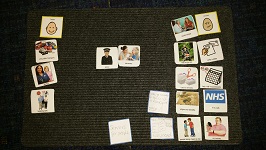
People raised concerns about a variety of issues to do with service cuts, from cuts to the NHS and the need for local pharmacies to stay open, to cuts to transport and the need for additional support with relationships. One person mentioned specifically that she wanted to feel safe at home and talked about crime directed towards people with learning disabilities. Most people were worried about benefit cuts
We had some positive responses, one person wanted to highlight how happy she feels in her new flat and one person specifically wanted to compliment his local councillor who he felt really listened to people with learning disabilities. Ivan Lewis MP tweeted his support for the campaign. In terms of learning for next year’s conference, we will develop the vocabulary and the process of collecting e mail addresses and twitter accounts for MP’s. One very valuable lesson we learned about the numbers engaged in the activity was to hold next year’s sessions before the party on the last night. It seems the participants at the self advocates conference work hard and play hard too!
Alison Matthews is a Speech & Language Therapist, Director of Total communication Services CIC and member of the North West Learning Disability Alliance
April 2016
Talking Mats was used as part of a Speech and Language therapy assessment for a boy with a stammer (dysfluent speech). He was very aware of his stammering and would change what he was going to say or avoid some situations because he anticipated that he would stammer. He had low self-esteem about his speech and felt that whenever anyone laughed in his class, it was to do with his stammer.
Talking Mats was used to gather information about which situations and people made speaking easier, and any situations and particular people which caused more of a challenge. The activity provided much more information than originally anticipated.
A starter mat was used to show how a Talking Mat worked, using pictures of food. He engaged well with this, and understood the process quickly. We then moved onto discussing his speech – we wrote names of people in his life and situations which involved speaking onto pieces of paper, and he placed these on the mat where he felt appropriate. We started with people and situations which appeared more positive, then gradually moved onto those it was anticipated would be more challenging.
His insight into his speech and what helped him or made speaking more difficult was impressive. We were able to use this information to compile a list of “Do’s and Don’t’s” for people he came into regular contact with. He agreed that this information could be shared with school to give them strategies to support him there.
The most powerful part of the Mat was him being able to say that he did not feel happy about talking with his big brother sometimes, because he could make fun of his speech, and this made him feel really upset. This was a powerful revelation for his Mum who had sat in on the session, as she had not realised he felt this way. After the session, the family had a chat around the table at tea-time about how his therapy session had gone that day – with Mum’s support he was able to say to his brother about how his teasing had made him feel. His older brother had thought it was all a bit of fun and hadn’t realised the impact it was having. They agreed the older brother wouldn’t tease him anymore.
When he came back for his next session, he commented on being much happier about his talking at home, and felt the activity had been really helpful. His Mum was very positive about it too, and proud of how he had managed to speak up for himself and be able to say how other people could help him with his talking.
Our thanks to Kirsten Taylor, Speech and Language therapist for sharing this powerful story
 Online training login
Online training login 


